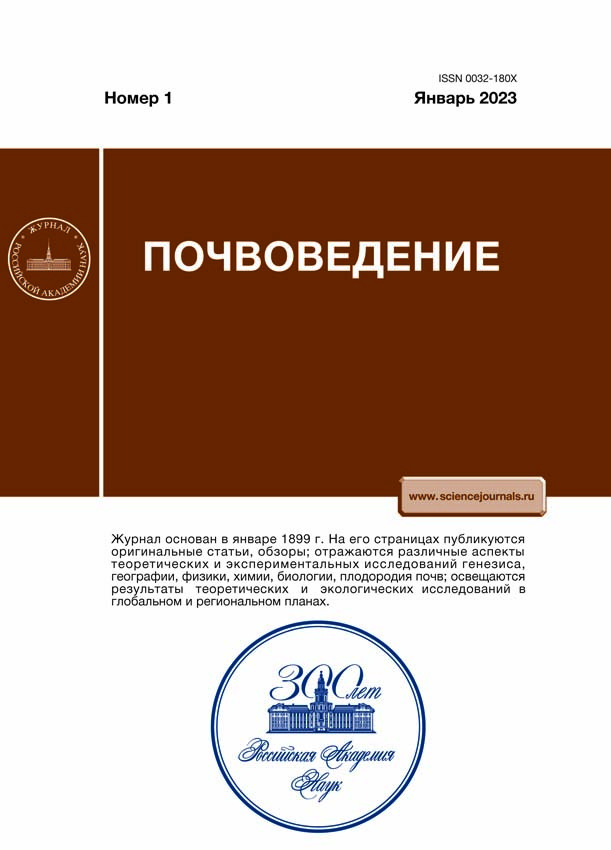Microbiological Activity of Chernozem in the Combined Use of Potassium Chloride with Nitrogen Fertilizers
- Authors: Pavlov K.V.1, Morachevskaya E.V.1, Vlasova A.P.1, Manucharova N.A.1
-
Affiliations:
- Lomonosov Moscow State University
- Issue: No 1 (2023)
- Pages: 74-80
- Section: АГРОХИМИЯ И ПЛОДОРОДИЕ ПОЧВ
- URL: https://kld-journal.fedlab.ru/0032-180X/article/view/665905
- DOI: https://doi.org/10.31857/S0032180X22600822
- EDN: https://elibrary.ru/JKHJIQ
- ID: 665905
Cite item
Abstract
In order to assess the possible toxic effect of potassium chloride used in conjunction with mineral nitrogen fertilizers the authors studied the structural and functional components of the microbial complex of chernozem, in particular, its prokaryotic component. The object of research was soil samples of typical chernozem, selected from the vegetation experience with variants with the introduction of nitrogen-phosphorus and ni-trogen-phosphorus-potassium fertilizers. To obtain a stable effect of easily soluble salts on the microbial community of the soil, long-term composting of soil samples was carried out with alternating cycles of moistening and drying of the soil. During the first two years of composting, the researches detected the suppression of carbon dioxide emissions; however the suppression leveled out only 5 years later. The initial reduction in carbon dioxide emissions, as well as denitrification activity, reached twofold values. The negative effect was manifested when the content of chlorides and nitrates in the soil was significantly lower than the gradation established for slightly saline soils. Prolonged composting of samples of fertile chernozem under the action of potassium chloride led to a decrease in the number and biomass of the metabolically active prokaryotic complex, which confirms its toxic effect on the microbial community of the soil. The representatives of the prokaryotic complex that are resistant and sensitive to the increased content of chlorides and nitrates in the soil have been identified. Among the representatives of the Bacteria domain, almost all were sensitive, with the exception of two phyllum Firmicutes and Verrucomicrobia. For some representatives of the phylogenetic group Actinobacteria, sensitivity to chlorine ions is confirmed at the generic level (Streptomyces and Micromonospora). For the Archaea domain, representatives of the Euryarchaeota phylum are identified as the most resistant to the presence of chlorides. Thus, the suppression of the microbiological activity of chernozem during the introduction of potassium chloride explains the previously identified decrease in the availability of nutrients for plants.
About the authors
K. V. Pavlov
Lomonosov Moscow State University
Email: agrosoil@mail.ru
Russia, 119991, Moscow
E. V. Morachevskaya
Lomonosov Moscow State University
Author for correspondence.
Email: agrosoil@mail.ru
Russia, 119991, Moscow
A. P. Vlasova
Lomonosov Moscow State University
Email: agrosoil@mail.ru
Russia, 119991, Moscow
N. A. Manucharova
Lomonosov Moscow State University
Email: agrosoil@mail.ru
Russia, 119991, Moscow
References
- Благовещенская Г.Г., Духанина Т.М. Микробные сообщества почв и их функционирование в условиях применения средств химизации // Агрохимия. 2004. № 2. С. 80–88.
- Классификация и диагностика почв России. Смоленск: Ойкумена, 2004. 342 с.
- Манучарова Н.А., Власенко А.Н., Менько Е.В., Звягинцев Д.Г. Специфика хитинолитического микробногокомплекса в почвах, инкубируемых при различных температурах // Микробиология. 2011. Т. 80. № 2. С. 219–229.
- Манучарова Н.А., Ксенофонтова Н.А., Каримов Т.Д., Власова А.П., Зенова Г.М., Степанов А.Л. Изменение филогенетической структуры метаболически активного прокариотного комплекса почв под влиянием нефтяного загрязнения // Микробиология. 2020. Т. 89. № 2. С. 222–234. https://doi.org/10.31857/S0026365620020093
- Манучарова Н.А., Степанов А.Л., Умаров М.М. Особенности микробной трансформации азота в водопрочныхагрегатах почв разных типов // Почвоведение. 2001. № 10. С. 1261–1267.
- Методы почвенной микробиологии и биохимии / Под ред. Д.Г. Звягинцева. М.: Изд-во Моск. ун-та, 1991. 304 с.
- Мякина Н.Б., Аринушкина Е.В. Методическое пособие для чтения результатов химического анализа почв. М.: Изд-во МГУ, 1979. 62 с
- Павлов К.В. Оптимизация калийного питания ячменя при локальном внесении калийных удобрений // Агрохимия. 2009. № 2. С. 28–34.
- Павлов К.В., Клешканова Е.В., Новиков М.М., Манучарова Н.А. Влияние хлористого калия на эмиссию диоксида углерода из чернозема // Вестник Моск. ун-та. Сер. 17. Почвоведение. 2015. № 2. С. 49–52.
- Павлов К.В., Новиков М.М. Влияние локального внесения калийных удобрений в чернозем на урожайность ячменя // Агрохимия. 2013. № 4. С. 48–54.
- Практикум по агрохимии / Под ред. В.Г. Минеева. М.: Изд-во Моск. ун-та, 2001. 689 с.
- Семенов М.В., Манучарова Н.А., Краснов Г.С., Никитин Д.А., Степанов А.Л. Биомасса и таксономическая структура микробных сообществ в почвах правобережья р. Оки // Почвоведение. 2019. № 8. С. 974–985. https://doi.org/10.1134/S0032180X19080124
- Bar Y., Apelbaum A., Kafkafi U. et al. Relationship between chloride andnitrate and its effect on growth and mineral composition of avocadoand citrus plants // J. Plant Nutrition. 1997. № 20. P. 715–731.
- Chabra R., Ringoet A., Lamberts D. Kinetics and Interaction of Chloride and Phosphate Absorption by Intact Tomato Plants (Lycopersicon esculentum Mill.) from a Dilute Nutrient Solution // Zeitschriftfür Pflanzenphysiologie. 1976. V. 78. № 3. P. 253–261.
- Ibekwe A.M., Poss J.A., Grattan S.R., Grieve C.M., Suarez D. Bacterial diversity in cucumber (Cucumis sativus) rhizosphere in response to salinity, soil pH, and boron // Soil Biology and Biochemistry. 2010. V. 42. № 4. P. 567–575.
- Massa D., Mattson N.S., Lieth H.J. Effects of saline root environment (NaCl) on nitrate and potassium uptake kinetics for rose plants: a Michaelis–Mentenmodelling approach // Plant Soil. 2009. № 318. P. 101–115. https://doi.org/10.1007/s11104-008-9821-z
- Miklos E. et al. Nitrate and chloride transport interaction in grapevine // Acta Horticulturae. 2000. № 526. P. 249–254.
- Wen Z., Tyerman S.D., Dechorgnat J., Ovchinnikova E., Dhugga K.S., Kaiser B.N. Maize NPF6 proteins are homologs of Arabidopsis CHL1 that are selective for both nitrate and chloride // Plant Cell. 2017. V. 29. P. 2581–2596. https://doi.org/10.1105/tpc.16.00724
Supplementary files













